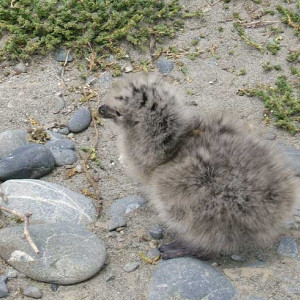From September 2023 until February 2024 we're conducting a Karoro/Southern black-backed gull control operation, at the Ashley River/Rakahuri.
Southern black-backed gull/karoro control
We run extensive control operations for Southern black-backed gull/karoro on braided rivers to safeguard endangered bird species and prevent E.coli contamination in popular swimming spots.
Why karoro are a threat
Karoro populations have been increasing in New Zealand/Aotearoa for more than 100 years and are abundant throughout the country. In Canterbury/Waitaha, numbers are estimated to be greater than 100,000.
They have exceeded previous record numbers in some areas because they can exploit favourable conditions. Greater food availability in urban areas and the development of rural land have increased favourable habitat.
Like all scavengers, they are opportunistic predators that prey on the eggs and chicks of black-fronted tern/tarapirohe, black-billed gull/tarāpuka, wrybill/ngutu pare, and banded dotterel/tūturiwhatu, all of which are threatened birds that breed on braided rivers.
Another reason is to protect rivers and popular swimming sites from E.coli, as this contaminant has been traced to karoro colonies.
How to identify karoro
Southern black-backed gull/karoro (Larus dominicans) also known as the kelp gull, Dominican gull, mollyhawk, and seagull, is the largest gull in New Zealand
- Adults have a white head and underparts, black back, yellow bill with red spot near the tip, and pale yellow-greenish legs.
- Juveniles are a dark mottled brown, with a black bill and legs; plumage lightens with age, moulting into adult plumage at three years.
Learn how to tell different bird species apart.
About the karoro control programme
The karoro control is supported by local water zone committees, the Department of Conservation (DOC), the Canterbury Regional Council (Environment Canterbury) and BRaid.
It is part of a wider habitat enhancement programme. Other projects include clearing weedy vegetation from some river islands to create open, safe areas for threatened birds to breed, and bird surveying and monitoring.
This past summer (2023/24), there have been karoro control operations on several braided rivers throughout the region.
How we control karoro
Large-scale control operations use the toxin alpha-chloralose. For smaller operations and follow-up control, shooting and egg destruction are also used.
Alpha-chloralose use
Alpha-chloralose is an anaesthetic compound registered for the control of karoro. It is mixed with margarine, applied to a bread bait and hand-laid directly within gull colonies. Pre-feeding is carried out four to six times before the operation to make sure baits are readily taken up within minutes.
Toxicity to humans and pets
Alpha-chloralose in bait form (baited bread) is toxic to people and pets if directly eaten. Poisoning could also occur by eating poisoned gull carcasses.
Symptoms of alpha-chloralose poisoning include drowsiness, loss of coordination and, if large quantities are ingested, a reduction in body temperature.
Anyone suspecting ingestion of toxic baits by a person or by a pet should seek immediate medical help, or veterinary help, as there are effective treatments for accidental alpha-chloralose poisoning if sought immediately.
Toxicity to fish
Alpha-chloralose is moderately toxic to fish. Because of this, it is used in such a way that it does not come into direct contact with water because the baits are laid on river islands and riverbanks.
Further, pre-feeding is carried out with non-toxic bread baits (four to six times) to condition the black-backed gulls to the toxic baits and make sure they are eaten within minutes of being laid.
Clearing any uneaten baits and gull carcasses within 24 hours also prevents them from being washed into the river following rainfall.
Current control works
We engage with mana whenua, adjacent landowners and local veterinarians ahead of control operations.
All karoro control works are listed on our current works webpage and signage is erected on-site.
A predator control programme is increasing the odds of breeding success for black-billed gull/tarāpuka on the Charwell River.















